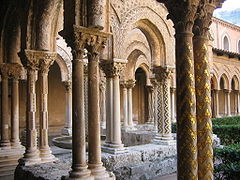Monreale
You can help expand this article with text translated from the corresponding article in Italian. (March 2022) Click [show] for important translation instructions.
|
Monreale | |
|---|---|
| Comune di Monreale | |
 Interior of Monreale Cathedral. | |
UTC+2 (CEST) | |
| Postal code | 90046 |
| Dialing code | 091 |
| Patron saint | St. Castrensis |
| Saint day | 11 February |
| Website | http://www.monrealeduomo.it/ |
Monreale (/ˌmɒnriˈæl/; Italian pronunciation: [monreˈaːle]; Sicilian: Murriali[3]) is a town and comune in the Metropolitan City of Palermo, in Sicily, southern Italy. It is located on the slope of Monte Caputo, overlooking the very fertile valley called "La Conca d'oro" (the Golden Shell), a production area of orange, olive and almond trees, the produce of which is exported in large quantities.[4] The town, which has a population of approximately 39,000, is about 7 kilometres (4 miles) inland (south) of Palermo, the regional capital.
Monreale forms
History
After the occupation of Palermo by the Arabs (the
Monreale was a small village for a long time. When the
Under King William II, a large monastery of
In the 19th century, underage marriages, or those performed without the blessing of the bride's parents, were known as "the marriages of Monreale", according to Eliza Lynn Linton. These referred to marriages performed in remote places, where the law was less observed.[6] (see Gretna Green).
Main sights
This section is written like a encyclopedic style or move the content to Wikivoyage . (March 2022) |


The Cathedral
The cathedral of Monreale is one of the greatest extant examples of
The church is a national monument of Italy and one of the most important attractions of Sicily. Its size is 102 metres long and 47 meters wide. The façade is characterized by two large towers (one partially destroyed by lightning in 1807) and a portal with
Other sights
- Castellaccio ("Bad Castle"), an example of a fortified convent on the Monte Caputo, at 764 m above sea level. It was built in the 12th century by King William II together with the Cathedral and the annexed monastery. It measures c. 80 x 30 m on an irregular plan with four towers on the western side, a middle tower and an entrance tower on the eastern side.
- is from 1396.
- Church of Collegiata (16th-19th centuries)
- Church of Santa Ciriaca
- Church of San Silvestro
International relations
Monreale is
Notable people
- Rocky Segretta (1899–1953), American football player
See also
References
- ^ "Superficie di Comuni Province e Regioni italiane al 9 ottobre 2011". Italian National Institute of Statistics. Retrieved 16 March 2019.
- ^ "Popolazione Residente al 1° Gennaio 2018". Italian National Institute of Statistics. Retrieved 16 March 2019.
- ^ "Monreale" is a contraction of monte-reale, "royal mountain", so-called from a palace built here by Roger I of Sicily
- ^ a b c One or more of the preceding sentences incorporates text from a publication now in the public domain: Chisholm, Hugh, ed. (1911). "Monreale". Encyclopædia Britannica. Vol. 18 (11th ed.). Cambridge University Press. p. 736.
- ^ Rodo Santoro: Palermo Cathedral,' Palermo: 1999, p. 7
- ^ Linton, Eliza Lynn (1885). Some Sicilian Customs (41 ed.). 'The Eclectic Magazine'.
The church did not sanction marriage younger than these several ages [20 for men, 18 for women], save in exceptional cases; and anyone who assisted at the marriage of a girl below the age of 18, without the consent of her parents or guardians, was imprisoned for life and forfeited all he had. This law, however, was frequently broken in remote places, and especially about Palermo, where "the marriages of Monreale" have passed into a proverb. When a young girl, say of sixteen, marries and has a good childbirth, they say "She has been to Monreale".
- ^ "Bielsko-Biała - Partner Cities". 2008 Urzędu Miejskiego w Bielsku-Białej. Retrieved 2008-12-10.


